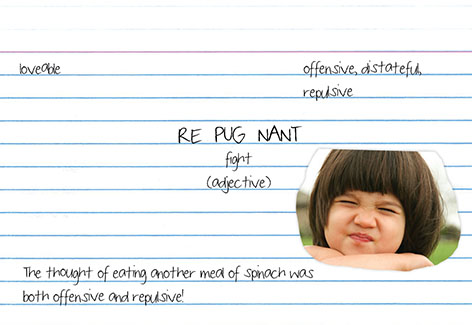What?
When?
Before reading
Why?
Vocabulary frames combine several word-learning strategies in a single diagram. Students use structural or morphemic analysis by examining word parts and roots, and contextual analysis by writing sentences and identifying antonyms. Using a graphic helps many students retain the new word.
How?
- Choose vocabulary words from the central text. Select a subset of root-based words that introduce new concepts.
- Create a sample vocabulary frame:
- Write a vocabulary word in the center of the card.
- Isolate any word parts (prefix, suffix, and root).
- Note the meaning of each word part.
- Note the part of speech in parentheses.
- Write a vocabulary word in the center of the card.
- Write the word’s definition in the top right corner.
- Write the word’s opposite in the top left corner and cross it out.
- Draw a picture in the bottom right corner to help visualize the concept.
- Write a sentence using the word in the bottom left corner.
- Lead students through the process of creating their own vocabulary frames and writing sentences. Have students consult dictionaries to ensure they understand the words' precise meanings and parts of speech.
English language learners
Be careful not to write in all capital letters when demonstrating a vocabulary frame or writing a new word onto an index card. Rules about capitalization differ across languages; it is important that English language learners be exposed to Standard English.
Connection to anti-bias education
Ask students to use the new word in an anti-bias or social justice context. Have students reflect on the author’s purpose, tone and point of view, then challenge students to use the word in a sentence that relates the anti-bias theme of the text to a personal, local or contemporary situation. For instance, say to students, “The word ‘repugnant’ was used in the text to describe the author’s feelings about racism. Write your own sentence using the word to describe a bias incident.” (See sample.)
Sample vocabulary frame:
